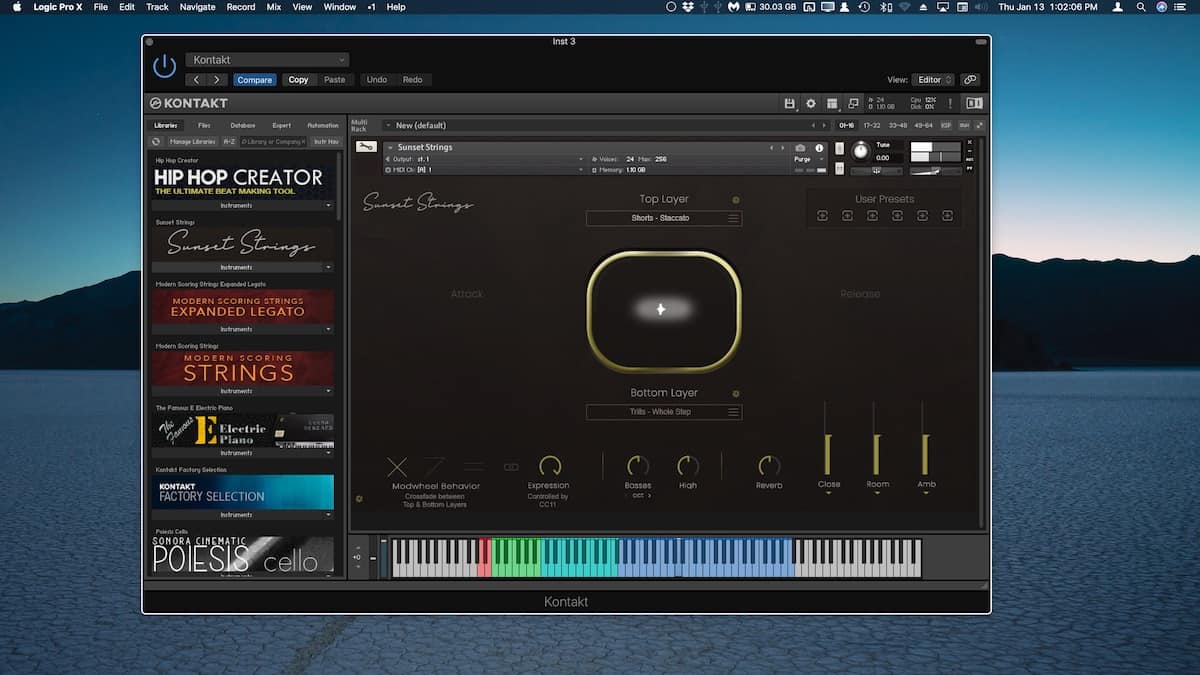Blog
Do Huge Computer Monitors Make Synths Sound Phatter?

Um, no. But just one software synth can fill your entire screen, so musicians shop for big ones – only to discover the difference between size, resolution, and dot pitch. Nick Batzdorf mansplains.
Check out the header graphic for this story. That’s just a single instance of Native Instruments’ Kontakt sampler taking over a 40” 4K monitor.
So, not being a fool, you run out and buy an 86” monitor… only to set it up and see that the image is identical, only larger.
Are you ahead of me yet? What follows are the three most important, interactive parameters to consider when you’re looking at monitors (either when considering which one to choose or literally looking at them in front of you!).
1. Resolution
Independently of their physical size, monitors can display different resolutions, measured in the number of pixels. The opening screenshot of Kontakt being greedy is with the monitor scaled down to 1080p resolution – that’s 1920 pixels across by 1080 height.
Here it is on the same monitor at 4K resolution, which is 3840 x 2160 pixels:
Screens have a native resolution, meaning the number of actual pixels they have. You can scale the picture above and below that resolution in software, either built into macOS or Windows or with third-party utilities (which can offer more flexibility, or sometimes monitor cards just come with their own utility).
Scaling above the native resolution means fewer pixels are used, so there may or may not be a noticeable effect and it’s generally not advisable. But displaying a lower resolution that’s supported by your video card (or chips) is absolutely fine.
Assuming you’ve chosen a monitor capable of displaying enough pixels, the game is to scale the picture so it’s comfortable for your eyes and viewing distance. That dovetails with the next parameter:
2. Dot pitch
This is the actual displayed size of the picture, determined by the physical size of the screen and the resolution at which you set it. It’s simply the number of dots per inch (well, technically it’s a measure how densely the pixels are packed, but it comes down to the same thing).
To put that in meaningful terms, the 30” Apple Cinema Display from the early 2000s had a dot pitch of .25mm. Apple must have done the research to determine a reasonable size for most people, me included (I happen to have good eyesight and run my current monitor at just over .22mm; I wouldn’t want to go smaller).
Here’s an online calculator (shown above) to help you determine the dot pitch at various resolutions for the size monitor you have or are considering. And another one for good measure.
By the way, laptops are a somewhat different case from the desktop monitors we’re talking about here. You’re generally sitting closer to them – yes, distance is another important consideration! – and their intended applications may be different. Recent models have the pixels to display at very high resolutions, but the picture is going to be small.
3. Monitor size
The main reason this warrants an explanation is that there are lots of very well-priced monitors that may sound like they’re big and appropriate for musicians, but they’re “gaming” monitors with lower maximum resolution than regular ones. A 32” gaming monitor might have a maximum resolution of 1920 x 1080 (1080p), while a standard 4K monitor, again, is 3840 x 2160.
Gaming monitors generally have very high refresh rates and are very responsive – which is what you want if you’re shooting at things, but you don’t care about that when you’re adjusting the filter on a software synth. We want pixels.
The conventional wisdom is to go for the biggest monitor you can, because screen real estate is your friend – and it is. But even leaving aside ergonomics (where are you going to put your speakers?), the larger the monitor, the farther you have to turn your head to see the sides.
Many people I’ve discussed this with like 40” 4K monitors on their desktops. The dot pitch is about the same as a 32” one run at 3008 x 1692 – around .23mm. Yet I tried one and replaced it with a 32” monitor.
Finally, no: we’re absolutely not going to end this story by saying “your mileage may vary.” We do not make use of clichés at Synth and Software, and automobile analogies are completely out.

















